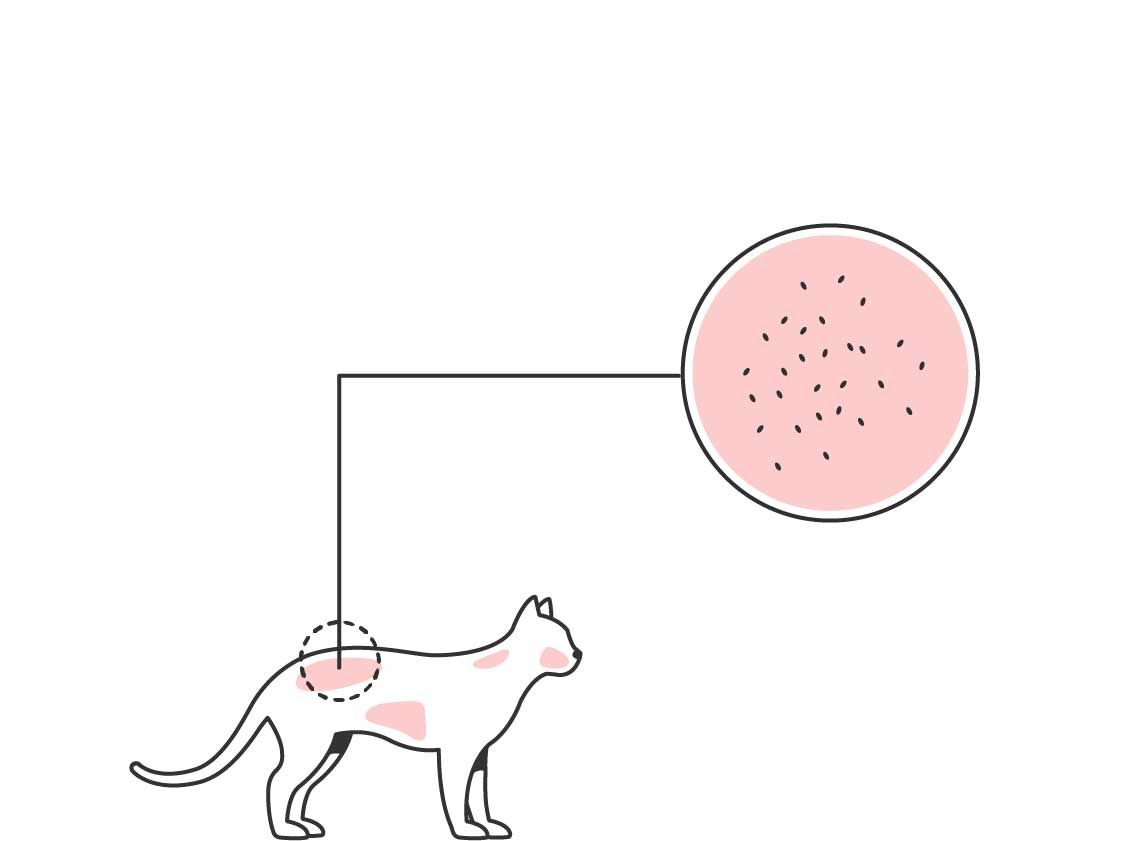Ear Dermatitis in Cats: Signs & Management
Article

Dermatitis is the general term for skin inflammation and is commonly caused by allergies, parasites, trauma, and fungal and bacterial infections. It’s a common health issue for cats.
The signs of dermatitis vary depending upon which condition is affecting a cat but will often include skin itchiness, redness, and hair loss. Dermatitis can affect different parts of a cat’s body, including its ears.
What Are the Signs of Ear Dermatitis in Cats?
The first thing you may notice is a change in your cat’s behavior. They may begin scratching their ears and shaking their head more than usual. Or they may spend more time grooming themselves and rubbing up against furniture.
When you look at their ears, you may see clinical signs such as:
- Redness
- Swelling
- Hair loss
- Dry or greasy skin
- Itchiness
- Dandruff and flaky skin
- Crusts, scales, sores, or ear scabs
- Oiliness
- A waxy discharge
- A bad smell

If your cat’s ears show signs of dermatitis, it’s possible that other parts of their body will be affected too. So be sure to check their paws, eyes, and coat for similar signs and talk to your vet.
Cats with dermatitis typically get very itchy skin and their natural response is to scratch, lick, and chew themselves to ease their discomfort. However, excessive scratching and biting can worsen signs, increase their risk of developing an infection, and may lead to open skin wounds.
A vet can offer advice to alleviate your cat’s itchiness and manage the underlying health condition that’s causing their ear dermatitis. So, it’s important to get your cat seen by a vet as soon as possible.
What Causes Ear Dermatitis in Cats?
Dermatitis is a sign of many health conditions in cats, like endocrine issues and auto-immune disorders. Some of the most common causes include:Food allergies
Sensitivities to ingredients in food, also known as food allergies, can lead to dermatitis issues that can appear anywhere on a cat's body, including its ears. A veterinarian will be able to identify whether a food allergy is present by carrying out a food trial to identify whether a certain ingredient is causing the signs of dermatitis. Learn more about eliminating certain foods from your cat's diet here.Environmental allergies
Environmental allergies occur when a cat’s immune system overreacts to a harmless substance called an allergen. The body's response can cause them to experience several signs, including ear dermatitis.
Many environmental allergens can trigger an immune system reaction in a cat, such as house dust and pollen.
You can find more information in our article: What Is Causing My Cat’s Allergic Reaction – Food or the Environment?
Parasites
Ticks, mites, fleas, and lice are just some of the parasites that can trigger skin irritation and inflammation in a cat.
When fleas land on a cat’s skin and infest their fur, the cat will scratch, chew, and bite themselves to try and relieve the itching. This can cause skin damage and worsen existing skin issues. If the cat has a flea allergy, it may also develop dermatitis which can lead to a secondary bacterial infection.

If you notice black ear wax or a crusty discharge from your cat’s ears, it could indicate an infestation of ear mites. These tiny, highly contagious parasites survive by feeding on the wax and oil inside a cat’s ear canal and cause a range of skin problems including ear dermatitis.
The best way to prevent parasitic mites is to frequently clean your home and apply year-round parasite management to your cat from your vet.
For further advice, read
how external parasites can affect your cat's skin.
Yeast Dermatitis
Yeast naturally forms on your cat’s skin and inside their ears.While yeasts are normally harmless to a cat, a change in skin conditions can cause these spore-like fungi to proliferate and cause disease.
Like other skin issues, yeast dermatitis can cause redness, hair loss, and inflammation. But you may also see thickening and darkening of the skin so that it starts to resemble tree bark or scales if the condition continues untreated for a long time. Typically, a foul smell accompanies the skin changes.
Depending upon the extent of the infection, your vet may recommend anti-fungal medications.
Diagnosis
Diagnosis methods will depend on what a veterinarian suspects is causing your cat's dermatitis.Allergy testing is commonly used, normally in the form of an elimination diet trial if a food allergy is suspected. This process identifies whether a particular ingredient is causing the inflammatory reaction. If it isn't a food allergy, a veterinarian may also consider the possibility that environmental allergens are causing dermatitis.
A veterinarian may carry out a skin scrape, skin biopsy or ear swab to test and examine for fungal or bacterial culture.
A veterinarian will also be able to confirm if external parasites are causing the irritation by performing a physical examination or a skin scrape.
Management of Ear Dermatitis
To understand how to support a cat that has been diagnosed with an illness causing dermatitis, speak to a veterinarian to receive tailored advice.
Depending on the diagnosis, taking into account the severity of the illness and your cat's individual needs, you may find your veterinarian recommends one of the below options:
- Topical treatments (medication applied directly to the skin)
- Long-term nutritional management
- Altering their natural surroundings
If you suspect your cat has an underlying issue causing dermatitis always speak to a veterinarian for a proper diagnosis and to receive tailored advice.
Can Nutrition Support a Cat With Ear Dermatitis?
Your vet will create a management plan to ease your cat’s ear dermatitis. Because many conditions cause skin issues, the remedies they recommend will vary based upon the underlying health issue that’s affecting your cat.
In some situations, a vet may suggest a change in diet to help improve a cat’s skin and gastrointestinal health.
A cat with dermatitis linked to food sensitivities, for example, may benefit from a tailored diet that supports their overall skin health. In which case a vet may recommend a hydrolyzed or novel protein diet.
You can learn more in our article Nutrition & Support for Cats with Food Allergies.
Related Articles
Like & share this page